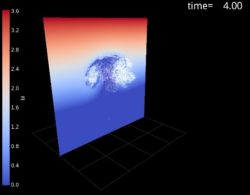Detailed microphysics in a Lagrangian cloud model
- Academic lead
- Alan Blyth (Earth and Environment)
- Industrial lead
- Paul Field, Met Office
- Co-supervisor(s)
- Onno Bokhove (Mathematics), David Dritschel (University of St Andrews), Steven Boeing (Earth and Environment)
- Project themes
- Geophysical flows
The turbulent behaviour of clouds is responsible for many of the uncertainties around the timing and intensity of precipitation in weather and climate models. One of the fundamental problems here is that cloud and precipitation processes are essentially Lagrangian: they happen along trajectories of the flow (for small particles) or fall trajectories We have recently developed a new method, MPIC (Moist Parcel-In-Cell), which deals with the dynamics of clouds in a Lagrangian framework, i.e. by advecting parcels of fluid. Here, we propose to use the MPIC method for studies of realistic atmospheric clouds and to couple the model to a bin microphysics scheme, where the amount of liquid water associated with drops of different size categories is prognosed. This bin microphysics approach has previously been successfully implemented in the Met Office LEM, but it is computationally expensive in this model. This is not the case in MPIC, as all the information about the droplets can be advected simply by changing the coordinates of a parcel. This work will build on a collaboration with David Dritschel (University of St Andrews) and will also involve comparison to the Met Office’s CASIM (Cloud AeroSol Interactions Microphysics) scheme.


